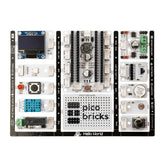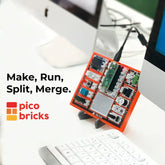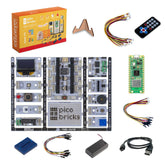What is Ultrasonic Level Sensor?
Table of Contents
Contactless measurement? Wow! Those magnificent technologies we see in movies are now in our homes! But the truth is, these amazing devices have become part of our daily lives. Therefore, we thought we should have more information.
In this article, we talked about the definition of the ultrasonic sensor, how it works, its varieties, advantages, and many more interesting information. Let's delve into the details of this exciting technology. Are you ready? Then let's get started!

What is Ultrasonic Sensor (HCSR04) ?
Ultrasonic sensor (HCSR04) operates like a covert gadget straight out of a spy's toolkit! These sensors are technological marvels based on the principle of sound waves beyond the range of human hearing. Emitting high frequency sound pulses, they then measure the time it takes for the sound waves to bounce back after hitting an object, thus determining distance. Renowned for their precision and versatility, these sensors find applications across diverse fields, from automotive parking assistance systems to industrial automation and even robotics. Their seamless integration into various devices and systems underscores their indispensability in modern technology, offering precise and reliable distance measurements across a wide spectrum of scenarios!
How Does Ultrasonic Sensor Work?
Ultrasonic level sensor working principle is like they've sprung out of a science fiction movie. These mysterious devices map the world around them using high frequency sound waves. Their operation is quite simple: the sensor emits sound waves at a predetermined frequency, which then bounce off an object and return. The sensor then measures the time it takes for these reflected waves to return, calculating the distance to the object. This process relies on the relationship between the speed of sound and the return time.

As a result, the sensor rapidly and accurately determines the distance to objects. This technology is used in a wide range of applications, from science fiction worlds where robots dance to the complex labyrinths of industrial facilities. Ultrasonic sensors, like the real heroes of a science fiction adventure, are waiting there to push the boundaries of modern technology.
Sensor Sensitivity: Why Every Millimeter Matters?
Because, high precision equates to high success!
One of the most crucial features of ultrasonic sensors is their sensitivity, which determines how accurately they can measure the levels of liquids and solids. In ultrasonic level sensors, sensitivity is like examining a piece of art; even the smallest details can make a significant difference. In a factory setting, an error of just a few millimeters can lead to production faults and financial losses, while high-precision sensors that provide accurate measurements can prevent such costly mistakes.
Ultrasonic sensors measure the heights of liquids and solids with millimetric precision. These measurements are particularly critical in the mixing of chemicals or in delicate liquid filling processes. Consider that in a pharmaceutical manufacturing facility, accurate measurement of components ensures the safety and efficacy of products. Therefore, 'sensor sensitivity' is not just a technical term, but also a symbol of safety and quality.
Types of Ultrasonic Sensors: Technological Solutions for Different Needs
These sensors are indispensable components of industrial automation and come in several types. Here are the most common types of ultrasonic sensors and their key features:
- Reflective Sensors (Echo Sensors):
- Operating Principle: These sensors measure the reflection of ultrasonic waves sent to an object.
- Applications: Ideal for short-range applications, such as tank level measurement or obstacle detection.
- Through-beam Sensors:
- Operating Principle: Measures the time it takes for waves to travel between two separate units.
- Applications: Preferred for measuring long distances; suitable for large warehouses or open storage areas.
- Adjustable Sensors:
- Operating Principle: Features adjustable sensitivity based on height, distance, and material type.
- Applications: Perfect for systems operating under variable conditions, such as factories working with multiple types of materials.
- Dual-point or Multi-point Sensors:
- Operating Principle: Can monitor multiple measurement points simultaneously.
- Applications: Situations requiring complex liquid level management, like intricate chemical processing plants.

Each type of sensor offers unique advantages for specific applications. Choosing the right type is critical for efficiency, safety, and cost effectiveness!
Advantages of Ultrasonic Level Sensors: Superior to Other Measurement Methods
Isn't the ability to measure without contact simply amazing? This enhances the safety of those working in environments filled with corrosive, hot, or hazardous materials, providing significant relief especially for professionals in dangerous industrial settings.
These sensors also offer high accuracy and repeatable measurements, ensuring reliable results every time. HCSR operates independently of external factors such as weather conditions and temperature, thus delivering exceptional performance even in challenging climates. The installation and maintenance of these devices are incredibly practical, saving you time and energy, and allowing you to say goodbye to complex calibrations!
In terms of energy efficiency, ultrasonic sensors stand out with their low energy consumption, which minimizes operational costs. Their wide measurement ranges easily cover capacities from small tanks to large storage areas, making them ideal for businesses of all sizes.
These sensors enable businesses to do more with less, maximizing operational efficiency and reducing costs. This technology is creating a productivity revolution in the business world and redefining industry standards.
Ultrasonic Level Sensor Maintenance and Troubleshooting: Secrets to Seamless Performance
HCSR ensures smooth operation of businesses with their precise measurements. However, for these devices to function efficiently, regular maintenance and timely troubleshooting are essential. Here are some golden tips for long lasting success:
- Spot Cleaning Operations:
- Give your sensors a spa day! Enhance their performance by cleaning the sensor heads from accumulated dust, dirt, and other foreign materials. Regular cleaning with a soft cloth and appropriate cleaners prevents measurement errors and extends the life of your sensors.
- Detailed Checks at Connection Points:
- The electrical and data connections are the lifelines of your sensors. Periodically check these connections for any signs of looseness or corrosion, and address issues promptly.
- Keep Your Software Fit:
- Keeping your sensors' software updated makes them smarter by equipping them with new features. Follow the manufacturer’s updates and apply them regularly.
- Smart Approaches to Erroneous Measurements:
- If your sensors are delivering unexpected results, first review the mounting angles and placement conditions. Environmental factors, especially intense foam or vapor, can affect measurements. In such cases, optimize the sensor placement.
- Defense Against Signal Loss:
- Experiencing signal loss? This might indicate that the distance between the sensor and the target is too great. Check for obstructions and adjust the sensor's position as needed to keep the signal path clear.
- Regular Performance Audits:
- Conduct regular tests to monitor your sensors, allowing you to detect potential problems early. This prevents major repairs and ensures operational excellence.
These strategies ensure that your HCSR always performs at their best, contributing to the uninterrupted operation of your business. Sensor maintenance and troubleshooting are not just technical tasks but also investments in the continuous success of your enterprise!

Ultrasonic sensors may seem like they belong in the realm of science fiction, but they are very much a part of our reality, enhancing our daily lives in numerous ways. From providing contactless measurements to ensuring precise and reliable results, these technological marvels have revolutionized various industries. As we journey through the intricacies of ultrasonic sensors, we uncover a world of innovation and efficiency, where every millimeter matters and every measurement counts.
So, let's embrace the power of ultrasonic technology and continue to push the boundaries of what's possible. With regular maintenance and strategic troubleshooting, we can ensure that these devices remain at the forefront of our technological endeavors, driving success and productivity in our businesses.
Together, let's harness the potential of ultrasonic sensors and pave the way for a future filled with endless possibilities!




